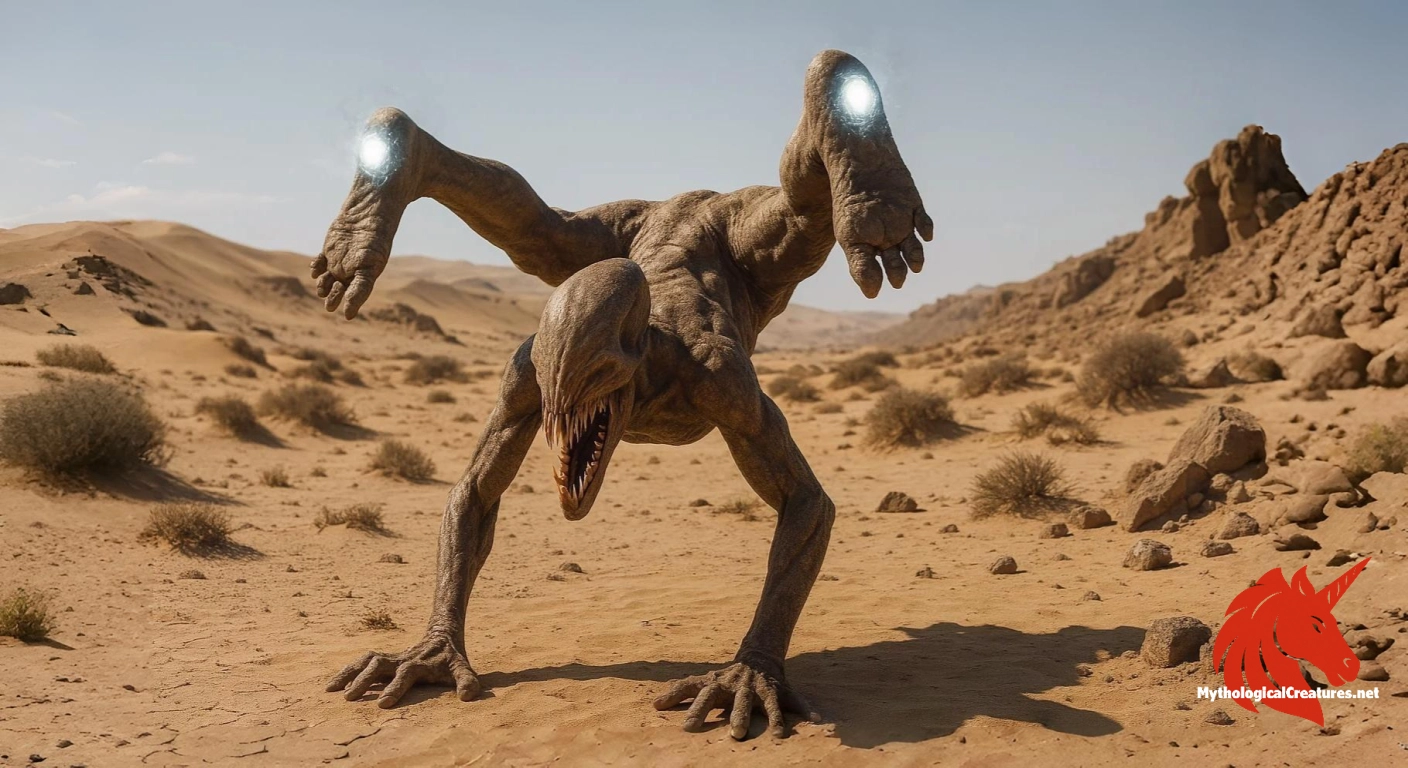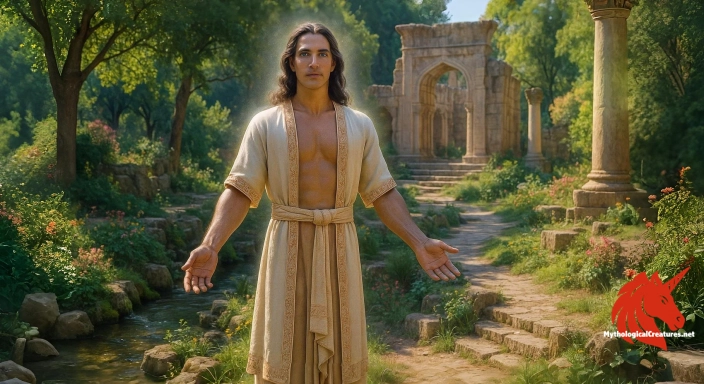Aigamuxa: The aigamuxa, also known as the Bushmen, is a legendary creature from Khoikhoi folklore.

Aigamuxa
Aigamuxa - Serves as a cautionary figure warning against the dangers of wandering alone in the desert.
Origins & First Encounters
The aigamuxa is a beguiling creature rooted in the traditions of the Khoikhoi people from the expansive Southern African deserts. Its legend weaves through indigenous narratives that explore the enigmatic forces of nature and the mysteries of survival. Often addressed by the appellation 'Bushmen', this monster blurs the lines between human familiarity and beastly otherness. Early attestations of the aigamuxa appear in ethnographic accounts from explorers traversing remote desert lands. Oral traditions vividly recount its nocturnal predations and serve as cautionary tales for those venturing into the harsh wilderness. The creature’s reputation for regarding humans as prey, much like zebras among the savannah, lends it a chilling and surreal character. Its myth continues to be a profound emblem of the balance between cultural storytelling and the unforgiving reality of desert life. The enduring narrative of the aigamuxa invites us to delve into an intricate tapestry of myth, survival, and the awe-inspiring mystery of nature. Its legacy remains a compelling chapter in the lore of the Khoikhoi and a testament to the powerful role of myth in understanding our environment.
Source Texts & Tale Variants
Primary accounts of the aigamuxa are most notably recorded in Aus Namaland und Kalahari by Leonhard Schultze-Jena, which provides one of the earliest literary snapshots of this formidable creature. Oral traditions among the Khoikhoi have preserved its eerie myth through an ever-changing tapestry of storytelling, ensuring that each narration carries its distinct local flavour. Early ethnographers recorded vivid descriptions that have since been woven into the broader corpus of African folklore. Multiple versions of the tale recount its bizarre physical attributes and its peculiar method of hunting under the cover of night. Folkloric texts continue to capture the paradoxical nature of a creature that must adopt unusual poses to visualise its surroundings. Some ancient manuscripts merge metaphoric elements with literal depictions, adding layers of symbolic meaning to its legend. The variegated narrative found in different texts highlights not only cultural particularities but also universal themes surrounding the human encounter with the wild. Modern researchers have revisited these accounts to better understand how indigenous voices transformed an ordinary fear of the unknown into an awe-striking myth. Each source, whether fieldwork or written record, invites readers to rediscover the rich mosaic of Khoikhoi tradition and its mirror to nature’s darker side.
Form & Powers
The physical portrayal of the aigamuxa is both striking and peculiar, marked by features that defy ordinary natural design. Its extremely elongated teeth are notorious, envisioned as instruments of a predatory precision that renders human prey vulnerable. A most unusual trait is the placement of its eyes on its feet, a detail that not only unsettles the observer but also necessitates bizarre bodily contortions for the creature to see. This anatomical quirk forces it to stand on its hands or head, or even lie in the sand, in order to gain a proper view of its surroundings. Descriptions often emphasise a lean, sinewy build that seems perfectly adapted to the unforgiving terrain of the desert. The creature’s appearance merges human elements with animalistic traits, offering a surreal image that challenges conventional anatomy. Varied accounts sometimes suggest a fluctuating size, alternating between a looming presence and a more proportionate silhouette that blends into the arid landscape. Its skin and form are frequently depicted as mirroring the stark textures of desert rock and sand, contributing further to its haunting image. The cumulative effect of these physical characteristics firmly establishes the aigamuxa as a mythic entity that exists on the very fringes of natural possibility.
Regional Faces
Within the diverse cultural landscape of Southern Africa, the lore of the aigamuxa adapts richly to local traditions and geographical narratives. Among different Khoikhoi communities, variations in the tale emerge, each influenced by distinct environmental encounters and societal values. Certain groups recount the creature as a spectral figure, its ghostlike presence accentuated by the vast, starlit desert nights. In contrast, other regional stories give it a more corporeal form, vividly describing a menacing predator lurking in isolated dunes. These local adaptations often reflect the practical concerns of survival in arid regions, integrating lessons on the perils of venturing alone into the expansive wilderness. The narrative is sometimes intertwined with communal rituals, where the terror it evokes is balanced by symbolic meanings related to nature’s capriciousness. Variations in the tale may also include subtle shifts in its reported abilities and methods of attack, tailored to the local landscape and cultural memory. This regional diversity enriches the overall mythos of the aigamuxa, making it a versatile symbol of both danger and the resilience of indigenous storytelling traditions. Such adaptability ensures that the creature remains a potent reminder of nature’s unpredictable force as seen through the eyes of different communities.
Cultural Parallels
When compared with other mythological predators, the aigamuxa occupies a unique place in the global tapestry of folklore. Much like the Wendigo or various shape-shifting apparitions in indigenous North American traditions, it encapsulates the fear of the untamed and the consequences of isolation in hostile environments. Its distinctive anatomical feature—eyes on its feet—sets it apart from other creatures that blend human and animal traits. Similar to legends found in myriad cultures that warn against the dangers of venturing into the wilderness, its narrative serves a dual purpose; both as a literal admonition and as an allegory for nature’s hidden perils. The creature’s habit of preying on solitary travellers resonates with cross-cultural myths that use predatory figures as symbols of vulnerability. In various mythic traditions, such warnings are integral to communal survival and the transmission of societal values. The comparative analysis reveals that while each culture tailors its legends to specific environmental and social contexts, common themes of transformation and transgression persist. The aigamuxa, therefore, not only reflects the unique attributes of Khoikhoi lore but also contributes to a broader dialogue about humanity’s enduring relationship with the mysterious forces of nature. Its persistent presence in comparative mythology highlights a universal fascination with the shadowy borders between civilization and the wild.
Legacy & Modern Evolution
Over the centuries, the legend of the aigamuxa has evolved from a cautionary tale rooted in ancient oral tradition to an enduring symbol in modern myth-making. Its narrative, steeped in the folklore of the Khoikhoi, continues to demand attention through reinterpretations in art, literature, and even film. Modern depictions often reimagine the creature with an emphasis on its surreal anatomical peculiarities and its eerie predatory methods. Contemporary artists and storytellers draw on the aigamuxa’s image to explore themes of isolation, vulnerability, and the relentless forces of nature. The creature’s myth has been reframed to comment on environmental challenges, particularly those related to the harsh realities of desert landscapes and climate change. Academic discussions and cultural debates often utilise the aigamuxa as a metaphor for the intersection of human fragility and the overwhelming power of nature. Its transformation over time underscores the dynamic nature of folklore, whereby traditional symbols are continuously reworked to suit modern anxieties and ideals. In this way, the legacy of the aigamuxa persists as a vital link between ancient indigenous narratives and contemporary cultural discourse. It remains a testament to the enduring power of myth as both a historical record and a creative canvas for exploring universal truths.
Interesting Fact
A peculiar aspect of the aigamuxa is its need to reposition its body just to see, a trait that both hampers and enhances its ambush predation tactics.
Quick Creature Info
Origin:
Associations:
Our Mythic Legendary Rating:

Also Sometimes Known As:
Habitat:
Supernatural Powers:
Physical Attributes:
Abilities:
Behavior:
Weaknesses:
Lore:
Related Creatures, Tales or Lore
- MManticore
- TTikoloshe
- GGrootslang
References
Discover Another Mythical Legend You May Not Have Heard Of?
Uncover the mysteries of ancient folklore and expand your knowledge of legendary beings from cultures around the world.
Dare to Meet the Airyaman....
Curated by the Mythological Creatures Team (rev. May 2025)
